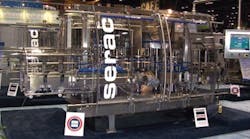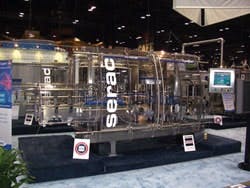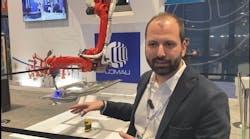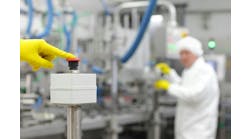Jim Montague is the executive editor for Control. Email him at [email protected].
It's always good to increase the scope of your awareness. Whether you happen to be a person or a machine, widening that radius means networking and communicating outside your usual sphere. Lately, a lot of human and industrial networking is being done via the Internet and in the cloud, but there's a point at which it all still depends on wires, cables, managed Ethernet switches, servers and other devices, which software-based interfaces and tools then coordinate.
For instance, Serac in Carol Stream, Ill., used pneumatic nozzles on its filling and capping machines, but users eventually requested more flexibility in order to easily change recipes to different products and quickly switch to different containers.
As a result, Serac developed and just released its new range of FC net-weight, filling-capping machines, which use Profibus for tasks such as coordinating load cells for weighing and stepper motors to control nozzles, so they can accurately fill containers from 50 ml to 1 gallon with a variety of products with varying compositions and handling requirements (Figure).
To avoid overloading industrial networks on machines, production lines and facilities, there are several basic steps, according to Wago’s Charlie Norz :
• Audit and examine what physical devices are connected to the network.
• Check existing PLCs for errors, and when they send blocks of data, verify they’re been received.
• Use software tools, such as Nessus Vulerability Scanner, to find all the Internet protocol (IP) address on the network, ping those addresses, and verify they’re from authorized devices.
• Deploy managed Ethernet switches and use them to segment large networks into smaller sub-networks or virtual local area networks (VLANs) separated by firewalls.
• Set up diagnostics tools in the switches to mirror ports, and then use traffic evaluation software, such as Wireshark, to monitor the network.
"Our users need to run thousands of different recipes for everything from window-cleaning fluid to potentially foamy mouthwash to very viscous cough syrup, and each of these products has to be handled differently and requires different valves, timing and nozzle settings," says Jean Luc Hostachy, Serac's technical manager. "Now, instead of changing valves, which could take anywhere from minutes to hours, operators just open a program, hit the right button, and the steppers and servos adjust the nozzles for just the right flow for that recipe and its container."
The FC machines employ nine circuit boards that each drive two stepper motors or two load cells for a total of 18 heads, which are connected to a slip ring, and controlled by a PC running proprietary software that Serac wrote for a Windows XP operating system. It also uses remote I/O modules and servo motors for machine feeding and all of them and FC's heads, PC boards, slip ring and I/O points are on Profibus, which is far simpler than wiring each device separately.
"Having stepper motors on the network doesn't just make the nozzles smarter and easier to adjust, it also makes them easier to clean," Hostachy adds. "We can just flush and be done, which means a lot less cleaning between products. In fact, this easier switchover even means FC can go tankless because it doesn't need a hopper."
Although deploying and networking I/O modules and managed Ethernet switches delivers these and other advantages, it's still important to make sure these new devices don't overload the network, according to Charlie Norz, product manager for I/O systems at Wago. "Fieldbuses are typically very robust, but as more and more devices get plugged in, signals can degrade, and they might not work as well," he explains. "So a network that only used to talk to PLCs could now have tablet PCs and smartphones trying to communicate with it, and that can add a lot of traffic. This is why it's important to divide networks into virtual local area networks (VLANs) and separate them with firewalls."
Less Cable, More Planning
Because industrial networking's primary commandment in modern times has been to reduce point-to-point wiring, it's no surprise that machine builders, end users, integrators and control/automation engineers have been using twisted-pair Ethernet and fieldbuses and their supporting routers, managed switches and other devices to help limit, design out or combine old-style cabling.
For example, Martin Kolb Steinbearbeitungsmaschinen in Bellenberg, Germany, builds sawing, cutting and polishing machines for natural stone up to 200 mm thick, and recently sought more integrated controls to improve accuracy and cost-effectiveness.
Most of the cutting is done by a bridge saw that's supported by a 15 kW (20 hp) motor, a lifter and adjuster that feed the saw at 1–2 m/min, and a turntable with an up to 90° swivel for complex shapes, which are in turn supported by a series of variable-speed drives (VSDs).
To integrate their controls, Martin Kolb's engineers recently worked with Eaton, which recommended its modular PLC and two 100 kHz counter modules to position the stone cutter's axes, while rotary encoders record values. The PLC is networked via CANopen to a 5.7 in. touchscreen HMI, which uses CoDeSys software to create and program displays that comply with the IEC 61131 standard. Consequently, datasets for the cutter's different motion positions are entered on the touchscreen and sent to the PLC via CANopen, while an Ethernet port is available for further programming and exchanging data via OPC with other systems. Likewise, machine parameters are also entered on the touchscreen, and this is where positions of the axes and the operating and cutting hours are displayed.
"We now can program our entire stone-cutting application with just one software tool," says Thomas Spitz, Martin Kolb's managing director. "All its devices communicate with each other using network variables, and the optional data exchange with other systems via OPC offers our customers enormous possibilities. We've offered a 24 hr service for a long time, and so we appreciate the remote diagnostics and telecommunications capability that this gives us."
Coordinating With Controls
Sometimes, instead of moving outward to larger systems, networks grow inward to work closely with individual machines and their controls.
Don Mannon, networking consultant for the eastern U.S. at Siemens Industry, says, "Network creep can occur when devices get added without checking how they affect the network's bandwidth and data throughput. You can avoid this by collaborating with the IT department on a network's initial design, but Siemens' TIA Portal can incorporate the appropriate managed switches when it designs a control system, and make them part of the project plan. As a result, the tag database will include tags for the switches along with those for the PLCs and I/O modules. The resulting configuration screen will show the network components and layout in one configuration tool; simple network management protocol (SNMP) diagnostics will be available; and the SCADA system will show alerts and alarms set up for different thresholds."
Mannon adds that TIA Portal and Sinema Server can also look at a baseline for overall machine performance, and then examine router and firewalls to filter and prevent any unauthorized packets from coming in.
Reach Out and Customize
Although all the planning and monitoring of networks required by fieldbuses, managed switches and their corresponding software might initially feel restrictive to technicians used to stringing wires or plugging in devices as needed, these standardized components and practices eventually grant more freedom to machine builders and system integrators to customize machines and production lines than in the past.
For example, Vakumix Rühr-und Homogenisiertechnik in Weyhe, Germany, builds 2–10,000 l mixing and homogenizing machines and production units for liquids from low-viscosity intravenous solutions to high-viscosity products for end users in the pharmaceutical, cosmetics, food and chemical industries, but it recently began integrating controls to help expand its export base.
"The basic design of our machines is the same, so the operating parameters are also very similar, just on a different scale," explains Robert Mueller, Vakumix's sales director. "However, 30% of any order we fulfill consists of customer-specific demands, so we have to be able to modify the machine's design and the operating parameters to meet these demands."
Consequently, Vakumix installed PACs with distributed I/O, VFDs and HMIs, and networked its panel with Ethernet switches. Among other tasks, these devices and their network, provided by Rockwell Automation, carry out application programming that Vakumix developed for its machines.
"The controller and drives are connected via EtherNet/IP, and supervised by a SCADA system," Mueller adds. "This combination allows a seamless connection between all subsystems, and helps reduce development and commissioning times. In addition, this system is ready to support the ISA S88 standard for the process industry."






